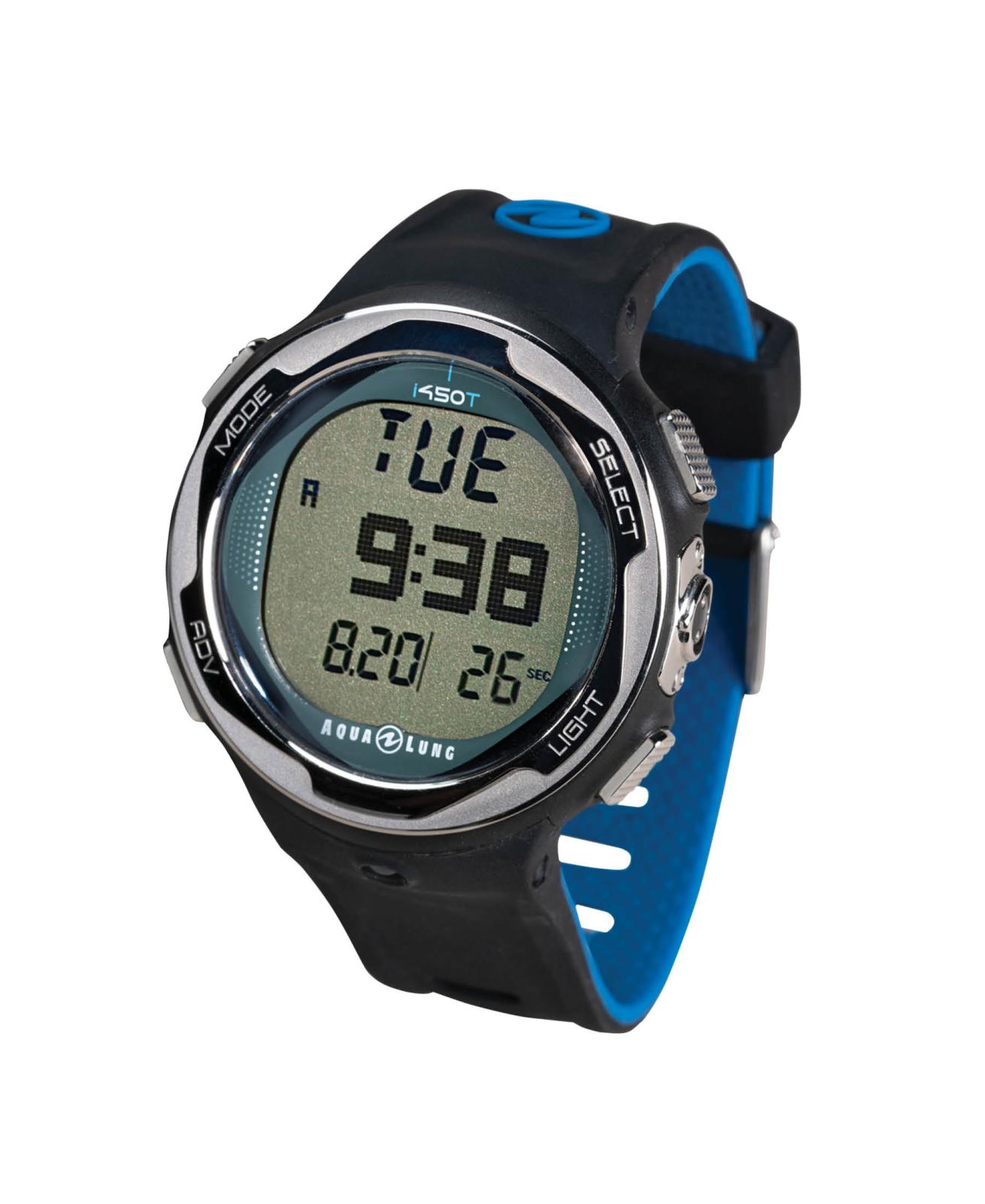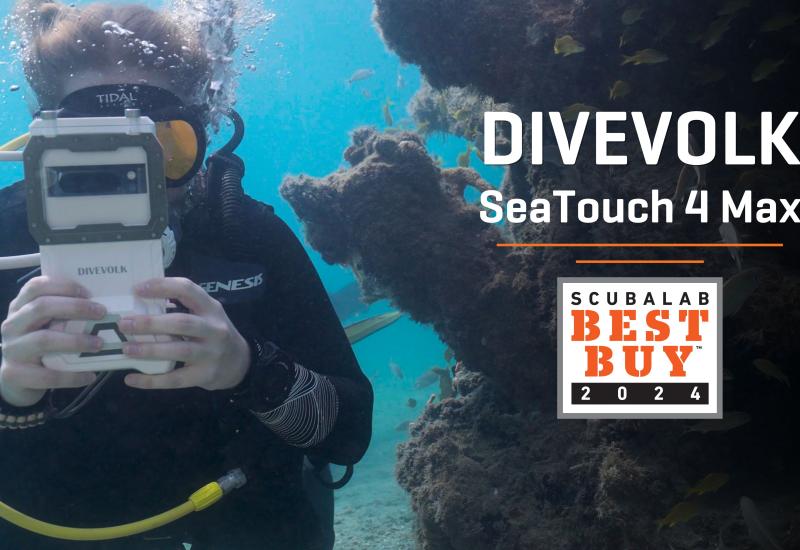The Best Dive Computers of 2019, Reviewed by ScubaLab

Jon WhittleScubaLab tested 14 new wrist, console and head-up-display computers.
HOW WE TEST
Our test evaluated two aspects of a computer’s performance: How easy it is to operate and understand before, during and after a dive; and an objective measure of its decompression algorithm relative to other computers in the test.
HOW WE SCORE
The top graph shows the score for intuitiveness of operation and the bottom graph shows the combined score for readability— surface and underwater—and data display, with scoring of:
5=excellent
4=very good
3=good
2=fair
1=poor
TEST DIVE PROTOCOL
Test divers evaluated computers in nine categories. Test dives were conducted at Blue Grotto Dive Resort in Williston, Florida, where divers recorded their scores in written comments about their experiences using each computer.
Test categories were:
■ Intuitiveness and ease of operation, including configuring settings
■ General ergonomics such as size and shape, comfort and effectiveness of buttons, straps
■ Ease of reading screen at the surface, including in sun
■ Ease of reading screen underwater, including performance of backlight
■ Overall quality of dive data display, including selection, layout and presentation of data, with a focus on how clearly it presents critical dive information
■ Usefulness and ease of accessing alternate dive screen data
■ Safety stop performance, including alerts and timer
■ Ease of accessing and usefulness of surface interval data, including no-fly time
■ On-board log data, including ease of accessing
ScubaLab staff also tested computers in a bench-top compression chamber to observe screen displays, warnings and alarms in conditions not suitable for testing by divers, such as rapid ascents and missed deco stops. The goal of these tests is to gauge how well each computer performed in providing a diver with clear, understandable guidance in those conditions.
OBJECTIVE TEST PROTOCOL
To gauge the relative conservatism or liberalism of the computers’ algorithms, they were subjected together to a series of four dive simulations in the University of Southern California Catalina Hyperbaric Chamber.
Meant to simulate a day of diving, the multi-stage profiles were: 100 feet/55 minutes; a one- hour surface interval; 70 feet/45 minutes; a two- hour surface interval; 80 feet/45 minutes; a one- hour surface interval; and 60 feet/40 minutes.
Special thanks to Catalina Hyperbaric Chamber Director Karl E. Huggins and chamber operators Benjamin Wright, Larry Harris and Aaron Kissel.
Wrist Models Over $500
Suunto D5

Jon WhittlePRICE Starting at $849.95 CONTACT suunto.com BATTERY Rechargeable Li-on
The three-button operation of the air-integrated D5 is so simple you can confidently navigate menus before even glancing at the manual. That earned the D5 a very good score for intuitive operation. The high-contrast color screen uses a reflective technology that enhances visibility in a wide range of light, and was easily visible in full sun—sometimes a weak spot for color displays. “Super easy to see in dark, sun or in between,” noted one test diver. The display packs a lot in without being cluttered, partly by putting some info in a changeable window at the bottom. The display makes good use of attention-getting colors, and audible and vibrating alarms are unmissable. Divers rated the display very good overall for quality of data — though not all liked the hash-mark indicator for minutes which to non-metric minds can mean feet. Slightly liberal in our chamber dives, the D5 was simple to set up, see and understand, and test divers chose it as an overwhelming favorite. The D5 is our Testers Choice for computers over $500.
Aqua Lung i450T

Jon WhittlePRICE $699 CONTACT aqualung.com, BATTERY User-replaceable
The i450T screen is loaded with data, but despite being less than 11⁄4 inches wide, it's relatively uncluttered, with bold, high-contrast characters. That helped it earn great scores for readability at the surface and at depth, where the programmable backlight was rated among the best. The four-button navigation is simple to master, and the menus are logical, earning a good score for intuitive operation. Rapid ascent, safety stop, deco entry and other alerts are crystal clear, with beeps and a flashing red light, along with clear instructions. Two gripes testers noted were the minutes-only safety stop display and the lack of Bluetooth. Divers liked the sophisticated look and feel of the i450T—a watch, as one tester noted, that you could “wear to dinner.” In our chamber dives, the i450T was average on the conservative/liberal scale.
Mares Genius

Jon WhittlePRICE $1,051 CONTACT mares.com BATTERY Rechargeable Li-ion
The Genius is big—nearly 33⁄4 inches wide— and no wonder, since it’s stuffed with advanced features. You can set its algorithm from eight preset rec or tec gradient factors, or choose your own custom factors. You can fine-tune with conservatism for “physio” (what shape you’re in), “today” (how you feel now), “dive” (dive conditions) and for repetitive or multi-day diving. The full-color screen was rated excellent for its data and readability, and it pairs with up to five tank transmitters. Still, the Genius is disarmingly simple to navigate, guided with screen prompts— though some icons took a while to figure out. It’s not really a computer for beginners; but for those with the diving chops—and wrist— to handle it, the Genius does it all. We set the Genius for average NDLs in our chamber dives, but its algorithm is highly adjustable.
Mares Quad Air

Jon WhittlePRICE $526 CONTACT mares.com BATTERY User-replaceable
Computers with crystal-clear displays can become cluttered once tank pressure is squeezed in. But that was no worry when the Quad (a previous Testers Choice) got an up- grade to the Quad Air, thanks to its 11⁄2 x 21⁄4- inch screen. The Quad Air remains, as one test diver said, “super-clear and easy to read.” It earned very good scores for readability at the surface and underwater. Basic data is clearly displayed, as is advanced info such as the run- away deco alarm. The four-button operation is a cinch to master, and the Quad Air was surprisingly ergo-friendly, even on smaller divers. Slightly conservative in our chamber dives, it has no digital compass, and Bluetooth re- quires an optional clip-on interface. But the Quad Air delivers AI, advanced features, simple operation and an easy-read screen at an attractive price. The Quad Air is our Best Buy.
WRIST MODELS UNDER $500
Aqua Lung i200C

Jon WhittlePRICE $369 CONTACT aqualung.com BATTERY User-replaceable
The "C" in the name reflects the welcome addition of Bluetooth, allowing easy connectivity to Aqua Lung’s free DiverLog+ app. Test divers gave the i200C a very good score for ergonomics, noting the sporty, compact design and the finger-friendly four-button operation, and scored it good for intuitive operation, thanks to its relatively simple menus and settings. The 11⁄4-inch display is basic but uncluttered, earning good and very good scores for reading at the surface and underwater, though some testers found the backlight just adequate. Deco warnings, tis- sue-loading and ascent-rate graphs, and adjustable safety-stop countdown are equally straightforward and comprehensible, even for the newest diver. In our chamber dives, the i200C’s no-deco times were about average compared with other computers in our test.
Cressi Neon

Jon WhittlePRICE $399.95 CONTACT cressi.com BATTERY User-replaceable
Despite the optional bright color accents, the Neon isn’t really about flash. What impressed testers was its simple operation, easy-reading display and pleasing ergonomics. The two-button control makes it a snap to navigate menus, and the high-contrast display is easy to see and understand, with info clearly labeled. “Basic functionality, but a joy to use and operate,” one tester observed. Test divers noted the Neon’s arm-friendly size, but our calipers showed it’s only millimeters less than some here; the trick is the recessed band lugs that make it seem smaller. One gripe was the lack of Bluetooth, which requires a down- load cable. But testers gave it top scores for intuitive operation, display quality and ergonomics. Slightly conservative in our chamber dives, the Neon is our Testers Choice for computers that cost less than $500.
Oceanic Geo 4.0

Jon WhittlePRICE $399.95 CONTACT oceanicworldwide.com BATTERY User-replaceable
The 4.0 version of the Geo has a four-button layout, and high-contrast LCD screen with bold, relatively large characters, given its watch-size design. “Pretty easy to see and read,” one tester commented; others agreed, giving the Geo 4.0 good and very good scores for legibility at the surface and at depth. The computer’s onboard log data is fairly basic, but Bluetooth makes it simple to download to the DiverLog+ app. Divers scored the Geo 4.0 good overall for ergonomics; while some found the Geo’s round control buttons a bit hard-edged on bare fingers, they liked the quick-release strap attachments with little slide bolts that allow speedy swaps between the regular and the long, over-the-wetsuit band. In our chamber dives, the dual-algorithm Geo was about average using the Z+ algorithm, and on the liberal end with the DSAT.
Oceanic Veo 4.0

Jon WhittlePRICE $399.95 CONTACT oceanicworldwide.com BATTERY User-replaceable
It's a little chunkier than some of the more watchlike models here, but divers still scored the Veo 4.0 good overall for ergonomics, as well as for its simple operation. “Very comfortable and easy to use,” one tester remarked. The two big oval buttons make it simple to confirm settings and navigate menus. The nearly 13⁄4-inch screen earned good scores for readability at depth and very good scores on the surface, thanks to its big, bold characters, clean layout and good backlight. The data itself is basic, both on the dive display and in the log. But it’s present- ed clearly and makes the most of the generous screen real estate, while Bluetooth allows easy downloads. We used the Z+ algorithm, which was about average in NDLs in our chamber divers, but the dual-algorithm Veo 4.0 also has the more liberal DSAT.
CONSOLES
Oceanic ProPlus 4.0

Jon WhittlePRICE $799.95 with QD and compass CONTACT oceanicworldwide.com BATTERY User-replaceable
“Bigger and better than ever,” Oceanic says of this latest ProPlus console. As for bigger, the characters are 22 percent larger than the ProPlus 3—now more than a half-inch tall. “I could read this screen from the parking lot,” quipped one diver. Not surprisingly, it took excellent scores for readability. Bluetooth does away with the need for a download cable and lets you access settings from a smart phone. The PP4 retains the dual algorithm and Dive Time Remaining display, which shows the least of no-deco or O2 time. Testers rated the two-button control very good for intuitive operation. Though it’s a handful, the ProPlus 4 took an excellent score for ergonomics, with its easy-grip curves letting it rest comfort- ably in our hands. In our chamber dives using the DSAT algorithm, it was on the liberal side.
Sherwood Wisdom 4

Jon WhittlePRICE $830.00 with QD and compass CONTACT sherwoodscuba.com BATTERY User-replaceable
The Wisdom 4 shares many features with the other console in our test, including Bluetooth, an intuitive two-button operation (one on the side), a quick-disconnect hose and large display characters. But its appearance is quite different, with slightly smaller overall size, oval-shaped screen and four-line display. The Wisdom 4's big, bold characters helped it take a very good score for readability both at the surface and at depth. It features a simplified “Safe Minutes” display that shows the dive’s current time-controlling factor, whether it’s no-deco limit, O2 exposure or gas time. A cool, functional feature on the Wisdom 4 is a dive simulator that runs single or repetitive profiles to see NDL and other calculations based on actual dive settings. In our chamber dives, the Wisdom 4 was on the liberal side.
HEAD-UP DISPLAYS
Scubapro Galileo HUD

Jon WhittlePRICE $1,399 CONTACT scubapro.com BATTERY Rechargeable Li-ion
The HUD’s optics make the thumbnail-sized display appear about the size of a 12-inch laptop screen viewed from arm’s length. Testers rated the color display very good for readability at depth, although they noted occasion- al glare at the surface. The display has standard, “lite” and profile views in dive mode; along with air integration, the HUD has adjustable algorithms, surface GPS, eight gas mixes, digital compass and Bluetooth. The push- wheel control is intuitive and makes for simple setting changes. The included mount—there's one for some Scubapro masks, and a universal mount that zip ties in place—has a quick adjustment to align the screen and swivels out of the way when it’s not needed. Test divers found themselves quickly appreciating the hands-free nature of the HUD. As one said, “Afraid this has ruined me for wrist computers.” In our chamber dives the HUD was on the conservative side, but its algorithm is widely programmable.
Shearwater Nerd 2 HUD

Jon WhittlePRICE $1,550 CONTACT shearwater.com BATTERY Rechargeable Li-ion
The reg-mounted NERD 2 uses a micro LCD display with a magnifier lens to produce a crisp, vivid color image of the advanced air-integrated computer inside. It’s no knock to note that the internal workings, like the screen view, appear to be lifted from Shearwater’s Perdix, a two-time ScubaLab Testers Choice winner and a model of pairing advanced capabilities with us- er-friendly operation. The NERD 2 has multi-gas compatibility; rec, tec and closed-circuit modes; a digital compass; two-button operation; detailed on- board log; and Bluetooth. The swiveling, hinged, almost-universal mount has a large range of adjustment but worked best on regs without oversize hose fittings. The screen was easy to read when in proper alignment, but also tended to shift with movement in the reg or hose—or even hard button pushing—though it was easy to nudge back into place. The NERD2's algorithm was set slightly liberal in our chamber dives, but is highly configurable.
Thalatoo Māoï

Jon WhittlePRICE $950 CONTACT thalatoo.com BATTERY Rechargeable Li-ion
Although it's not yet widely available in the U.S., we were curious to try a prototype of the Māoï because of its display, which projects onto a curved, transparent screen. Setup required plenty of adjusting, as our mount was held in place by a suction-cup bracket and elastic strap. (Another option is available for masks with an integrated GoPro mount.) The bright green screen characters stand out well at depth, though we weren't able to eliminate the faint ghost images in the display. The Māoï's “smart” screen option clears all but a luminous “still on” dot for an uncluttered display until no-deco time or other data demands attention. We’re told air integration is in progress, but for now you'll need to check the SPG. The front-facing buddy display makes it easy to confirm settings before donning the Māoï.










